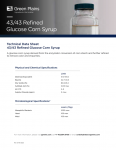Sugar 2.0? From low-GI sugar to next-gen sugars deploying ‘fluffy bulk’ technology to increase sweetness perception

Speaking to FoodNavigator-USA after raising $5m in a Series A led by agri-food venture fund VisVires New Protein, Nutrition Innovation Group co-founder Jimmy O’Mahony said that Nucane Raw low-glycemic index (GI) sugar - the first product utilizing the company’s patented technology (which it has licensed to sugar mills) - is now sold in several markets including Australia, Brazil, and Malaysia.
“It’s in retail sugar products, but the big opportunity is in industrial sales. Nucane can work in everything from chocolate to baked goods, gummies and flavored almonds.”
Clean labels
But how appealing is cane sugar that might be lower GI (O’Mahony claims blood tests on animal and human subjects prove it has less impact on blood glucose than refined white sugar), compared to sugar alternatives such as allulose, which has virtually no calories, no impact on blood sugar, and doesn’t count as grams of sugar on the Nutrition Facts panel?
First, Nucane is simply listed as ‘sugar’ on the label, which is more consumer friendly, said O’Mahony; second, it may also enable sugar reductions as its caramel notes mean it is perceived by some consumers as sweeter than refined sugar; and third, it may contain fewer calories than regular sugar owing to the way it is metabolized, although this has not yet been proven in human testing. Plus, it’s cheaper than allulose and erythritol, he said.
“One of the largest manufacturers we’re working with said they were not interested in anything [in the sugar or sugar alternative category] that contains ingredients you wouldn’t find in your Mom’s pantry.”
How is Nucane Raw made?
The manufacturing process for Nucane is described in a couple of patents (click HERE and HERE), which cover the process and the final composition of the sugar, but the end product retains the vitamins, minerals and phytochemical compounds naturally present in cane sugar.
“You can get less refined sugars right now, but they tend to be hygroscopic [they clump together making them hard to use in food manufacturing facilities], and have significant problems with variability,” claimed O’Mahony. “The Gl of these sugars is also variable.
“We’ve developed a process that creates a less refined raw cane sugar with low hygroscopicity that can be prepared at a low cost and to consistent specification in large quantities.”
What makes Nucane Raw low-GI?
But what makes it low GI? (Nucane is claimed to be lower than 55 on the glycemic index, whereas sucrose is typically 64-68 depending who you ask.)
According to O’Mahony, polyphenols that are usually removed during the refining process but remain in Nucane make it more difficult for enzymes in the gut to break down sucrose into glucose and fructose, decelerating the absorption process, and potentially reducing the overall amount of glucose that is absorbed.
“We’re doing work at the moment to test what is excreted from the body to see if there is a caloric impact,” he added.
Nucane Raw is being manufactured in commercial quantities by two sugar producers, with a further five producers commencing or undertaking trials, claims Nutrition Innovation Group. It is currently sold as a retail raw sugar in Brazil, Australia and Malaysia, and as an ingredient in branded food and beverage products in Australia.
Two patent applications have been published covering the manufacture and composition of Nucane, while a further five patent applications have been filed relating to the second generation of products that the company is developing under the Nucane Life brand.
Pictured: Nutrition Innovation Group co-founder and chief science officer Dr David Kannar at the Food Industry Asia Food for the Future summit in Singapore in April.
‘Fluffy’ sugar?
The next generation of products under the Nucane Life brand are made by spraying liquid Nucane low GI sugar over proteins (Nucane Energy), fibers (Nucane Fit) or intense sweeteners to create structures that contain holes when viewed under an electron microscope, explained O’Mahony.
This ‘fluffy bulk’ effect (a phenomenon also observed by Nestlé with its ‘structured’ amorphous, porous, sugar that is perceived as sweeter as it dissolves faster in the mouth) means Nucane Life products deliver more bang for your buck from a sweetness perspective with the same weight of sugar, he claimed.
But does Nucane Life retain its ‘fluffy’ structure in applications such as sauces or soups where the sugar melts?
“We’ve worked with chocolate manufacturers and some dairy applications and the structure remains,” said O’Mahony, “but we’re looking at lots of different categories now as it may retain its structure in some applications but not others.”
Alex Woo, Ph.D. chief executive at consultancy W2O Food Innovation, told us that Nucane Life "appears to be similar to Nestlé's 'cotton candy sugar' for chocolate and DouxMatok's 'sugar' for low/no water foods."
He added: "All of them are based on the same principle: Maximum surface area increases sugar kinetic release from foods to saliva then to sweetness receptors. Each company will need to demonstrate they have freedom to operate on its own technology."





















